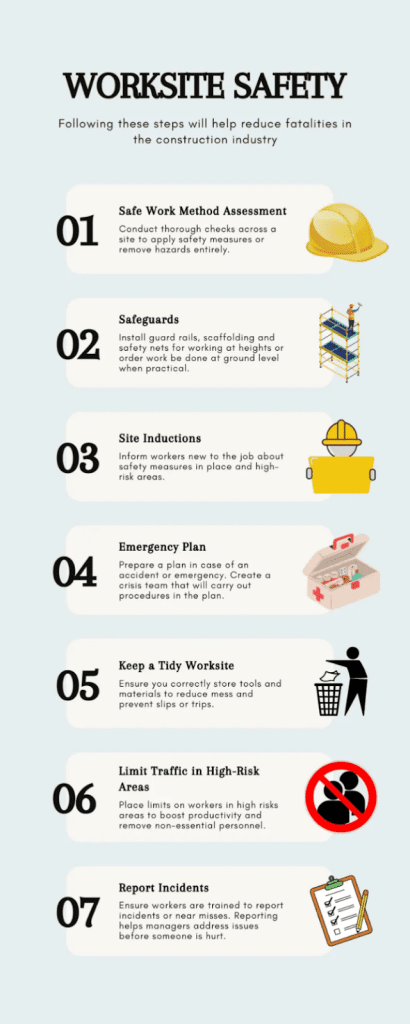The construction industry is extremely hazardous and one of Australia’s leading causes of workplace fatalities. A report on worker fatalities in 2019 found out of the 183 fatalities over the year, 26 occurred on construction sites.
The onus is on the site managers and businesses should an incident occur. Parties must assess and exercise safety measures to create a secure construction site.

Safe Work Method Assessment (SWMS)
Engineers on a construction site must conduct an inspection to identify safety hazards before work can begin.
The hierarchy of control is a framework for engineers to identify, mitigate, and eliminate safety risks. The hierarchy includes:
- Elimination: Involves erasing a safety risk completely;
- Substitution: Engineers substitute a safety risk with equipment;
- Isolation: Construction workers can isolate away from the hazard;
- Engineer and Administrative:
- Engineering solutions improve construction safety with equipment.
- Administrative controls influence or employ procedures for how people should work.
- Wear Personal Protective Equipment (PPE): Protective gear, including hi-vis, harnesses, safety goggles, and hard hats. The bottom of the hierarchy but still an essential step for all construction workers.
The law states that construction sites cannot initiate work until procedures are up to standard.
Safeguards
Worksites can install fencing and safeguards to protect construction workers from heavy machinery and fall hazards when multiple stories high. Safeguards include safety nets, fall protection systems such as scaffolding and guard rails, and fall arrest contraptions.
Alternatively, site engineers can identify fall hazards and order work to be completed at ground level if it is practical.
Site Inductions
An induction on every site allows companies to educate workers on new procedures, safety equipment, and high-risk areas.
Regular briefings are important for fast-moving construction sites with a rotating door of personnel each day.
Prepare an Emergency Response Plan
An emergency plan can direct workers on the procedure after an accident or hazard, including extreme weather events and chemical spills.
Scaffolding, in particular, requires inspections after turbulent weather to ensure the structure’s integrity is not damaged. Skipping an inspection increases the risk of a collapse and fatal injuries to those caught in the way.
A comprehensive plan will direct site managers and crisis teams on the correct procedure in the event of an accident or collapse. It is vital that they isolate the risk, arrange medical aid if needed, and protect workers from further harm.
A construction site can be chaotic in the aftermath of an accident. Without a plan, chaos and confusion can create new hazards and make a site even more dangerous.
By planning, companies avoid further confusion and harm and understand the steps required to make a construction site safe again.

Practice Correct Storage and Tidiness
Naturally, the construction industry is a very messy profession. Correct storage of power tools and unused materials can be the difference between an efficient worksite and another health and safety hazard.
Unattended power tools and building materials on ground level can result in unnecessary obstacles at ground level. They also can result in slips, trips, and falls.
Above ground level, the same items can fall from their platform. Workers below now must contend with falling objects that can become fatal.
By having dedicated storage areas and emphasis on tidiness, builders can limit the number of incidents with falling objects and improve workflow on-site.
Limit Traffic in High-Risk Areas
The construction industry is one of Australia’s largest, employing over one million people in 2022. Commercial projects employ a high volume of workers making it difficult to control health and safety on-site.
Lack of controls on the amount of foot traffic means a greater number of people in harm’s way in the event of faulty machinery or the spillage of hazardous material.
Regulating foot traffic in an area is a simple and effective solution. A great example is limiting or removing traffic beneath overhead lifting equipment until its task is complete.
Report Incidents
Unfortunately, managers and engineers can miss hazards even with rigorous risk assessment. That is why it is vital that businesses train personnel to report near misses and any safety risks they identify themselves.
Reporting allows management to address immediate issues instead of reacting to the aftermath.
Conclusion
Implementing safety training and procedure on-site help companies take strides toward a better working environment. A tidy workplace is safe, and protected workers ensure a productive project.
Building, Design & Construction Magazine | The Choice of Industry Professionals





